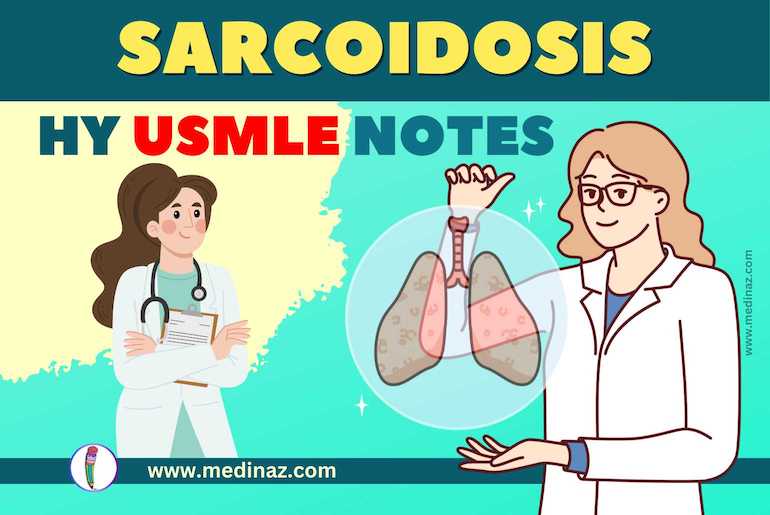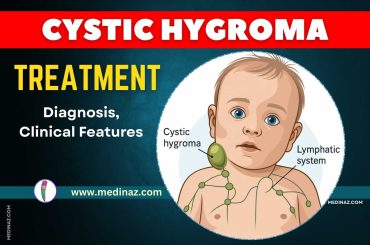Sarcoidosis USMLE Notes & Mnemonics contains all the high-yield points you need to know.
- Sarcoidosis: A multisystem granulomatous disorder of unknown etiology, characterized by the accumulation of T-lymphocytes and mononuclear phagocytes, noncaseating granulomas in organs.
Epidemiology
- Age: Often presents at <50 years
- Sex: More common in females
- Race: Higher prevalence in African Americans and Scandinavians
Etiology
- Unknown cause, but immune response to an antigen may be a factor (Ref)
- Possible environmental triggers in genetically predisposed individuals
Pathophysiology
- Formation of noncaseating granulomas in multiple organs
- CD4+ T-helper cells play a central role
- ACE level elevation: Due to production by epithelioid cells of granulomas
Clinical Features
- Lungs: Dyspnea, cough
- Skin: Lupus pernio, erythema nodosum
- Eyes: Uveitis, conjunctivitis
- Lymphatic: Bilateral hilar lymphadenopathy
- MSK: Arthritis, arthralgia
- Heart: Conduction abnormalities, cardiomyopathy
- CNS: Cranial nerve palsies, especially facial nerve
- Hypercalcemia: Due to 1-alpha-hydroxylase mediated vitamin D conversion in macrophages
Mnemonic for Symptoms: “GRUELING“
- G = Granulomas (noncaseating)
- R = Rheumatological (arthralgias, arthritis)
- U = Uveitis
- E = Erythema nodosum
- L = Lymphadenopathy (bilateral hilar)
- I = Interstitial lung disease
- N = Neurological (cranial nerve palsies)
- G = Gammaglobulinemia (hypergammaglobulinemia)
Diagnosis
- Chest X-Ray: Bilateral hilar lymphadenopathy, reticular opacities
- CT Scan: Assess for pulmonary fibrosis, nodules, ground-glass opacities
- Pulmonary function tests: Restrictive pattern, reduced diffusing capacity
- Serum ACE levels: Elevated, nonspecific
- Serum calcium: Hypercalcemia due to vitamin D activation by macrophages
- Biopsy: Noncaseating granulomas without central necrosis
- Bronchoalveolar lavage: Increased CD4/CD8 ratio
Treatment
- Asymptomatic: Observation
- Symptomatic: Glucocorticoids (first-line)
- Severe or refractory disease: Methotrexate, azathioprine, infliximab
Complications
- Pulmonary: Fibrosis, pulmonary hypertension
- Cardiac: Arrhythmias, heart failure
- Neurological: Seizures, neuropathy
- Ophthalmologic: Blindness
Prognosis
- Varies widely: many have spontaneous remission, others have chronic disease
- Prognostic factors: Acute presentation like Lofgren syndrome (erythema nodosum, fever, bilateral hilar lymphadenopathy, and polyarthralgia) has a good prognosis
Mnemonic for Prognosis: “PHACE“
- P = Pulmonary involvement severity
- H = Heart complications
- A = Ace levels (correlate poorly with disease activity)
- C = Calcium levels (hypercalcemia can worsen prognosis)
- E = Eye involvement
Note: This notes format is designed for quick review before USMLE exams; understanding pathophysiology and integrating clinical scenarios is essential for success. Always cross-reference with the latest guidelines and evidence.
Check other important USMLE Notes
A Visual Learning Platform





